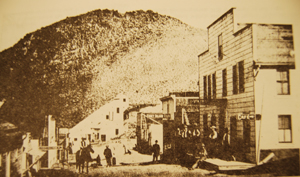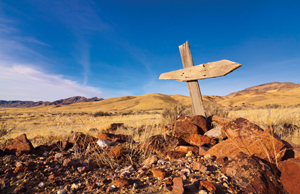Mazuma Wiped Out
Mazuma Wiped Out
100 years ago, a devastating flood dealt this small northwestern Nevada mining camp its deathblow.
BY MATTHEW B. BROWN | JULY/AUGUST 2012

Just prior to 5 p.m. on Thursday, July 18, 1912, Ed Kalenbauch and Ellsworth Bennett watched a cluster of ominous thunderheads hover over Granite Peak from the door of Kalenbauch’s office at Seven Troughs Coalition Mining Company.
They just so happened to comment on the storm’s potency when they saw a wall of water 10 feet high surge down Seven Troughs Canyon. Kalenbauch’s instinct was to alert the people of Mazuma, at the mouth of the canyon, who were in direct line of the ferocious wave.
Kalenbauch phoned the operator in Vernon, who phoned Fred Preston in Mazuma, but the electrical disturbance caused by the storm affected the line to such an extent that Preston only heard the one word: “water.” By then, it was too late.
Preston was one of the lucky ones. Or was he?
Yes, the owner of Preston’s Hotel would live to tell about the historic flood—something that couldn’t be said for eight other Mazuma residents—but he also had to survive with the nightmarish memory of the operator’s garbled voice and the frantic message that he never received.
A century later, we look back at a natural disaster that took the lives of nine Nevadans and wiped a town off the map.
DEATH TOLL
To give an idea of the tenacity of the raging floodwaters, a day after the flood, on the road near Vernon—some five miles away from Mazuma—the body of one of the Kehoe children was found by workers.
In one fell swoop, the cloudburst claimed almost a tenth of Mazuma’s population, which hovered around 100. In the sole stroke of luck for the town in this instance, only half of the residents were there when the flood hit.
Another death occurred at the mouth of Burnt Canyon, a short distance north of Seven Troughs Canyon. Many more people suffered serious injuries in what is still regarded by many as Nevada’s most destructive “gullywasher.”
Mazuma was officially established in 1907 without much thought given to the possibility of a flashflood—an oversight that can be easily understood in retrospect, given the nearsighted attitude of mining moguls of the era.
The 1912 flood came at a time during the early evening when housewives were preparing dinner, business owners were closing shop, children were playing in the streets, and miners and mill workers were preparing for the 5 p.m. shift change.
The wall of water (some eyewitness accounts estimated its height as high as 20 feet) first struck the Seven Troughs cyanide plant, smashing its walls and releasing dozens of gallons of hazardous chemicals into the flow. William Whybark averted disaster, when—at the last second—he was able to maneuver his Reo automobile onto higher ground. He climbed out just before the force of the water flipped the vehicle and carried it a short ways down the canyon.
The first residence hit was the cabin of Mike Whalen, who fell into the torrent and died. Perhaps the most heartbreaking deaths were those of three of John and Mamie Kehoe’s four young sons, who perished along with their friend, Perry Gillespie. Miraculously, one of the Kehoe children, eight-year-old Lewis, grabbed hold of a large wooden pole and was able to ride it out to safety.
Postmistress Maude Ruddell met her fate rather violently when the post office collapsed on her. Merchant John Trenchard and McLean’s grocery store clerk Margaret O’Hanlan were not able to act quickly enough, either. Julie Foncannon was the unlucky victim found in Burnt Canyon.
Rescue efforts were bleak at best. Washed-out roads met teams from nearby Lovelock. It was nearly dark before they arrived in Mazuma to witness the carnage. A temporary hospital and morgue was set up at Preston’s Hotel, ironically the only undamaged structure in town.
If only the Vernon operator’s warning could have come a few minutes sooner.
THE AFTERMATH
 Although they couldn’t undo the loss of lives, statewide response efforts were swift and generous. After receiving a telegram and learning of the devastation, Governor Tasker Oddie immediately called on Nevadans to assist the victims. Not that they needed much prodding.
Although they couldn’t undo the loss of lives, statewide response efforts were swift and generous. After receiving a telegram and learning of the devastation, Governor Tasker Oddie immediately called on Nevadans to assist the victims. Not that they needed much prodding.
Doctors and nurses traveled from as far as Reno to help with relief efforts. Bankers and local merchants set up donation boxes in their businesses, as well as sent personal contributions.
Other central Nevada towns were affected by the same storm, which only added to the outpouring of support. Although only minor flooding occurred in those communities, their citizens could surely relate. Even William Randolph Hearst of theSan Francisco Examiner set up a relief fund and personally contributed $100.
The Lovelock Relief Committee gave a final report of nearly $6,000 that went to aid the Seven Troughs Mining District flood victims. But Mazuma, its business district thoroughly destroyed, never did recover.
It has been said that it wouldn’t be a Nevada mining camp without a disastrous fire, but for Mazuma, its demise came by way of the flood. In fact, two more cloudbursts—one possibly more torrential than the July 18 one—occurred a few days later. They caused little damage, though, as a large channel had already been cut through the canyon. The other bit of irony is that the region was thirsty for water—the spring rains had not come in 1912, which had area farmers predicting that they would harvest only half the typical crop that summer.
To add insult to injury, fire did in fact find Mazuma—the Mazuma Hills Mill burned down 13 days after the flood. Seven Troughs escaped with minimal damage, except for the demolished cyanide plant.
TODAY

“Although mining and mill operations continued in the Seven Troughs District until the late 1930s, Vernon, Farrell, Seven Troughs, and Mazuma are today ghost towns in every sense of the word,” reads “Requiem for a Gullywasher,” by Phillip I. Earl in the Spring-Summer 1982 edition of The Humboldt Historian. That was written 30 years ago, so the sands of time have indeed made their mark on the few foundations that might still remain. Photo: Neil Lockhart
Nevada explorer and Reno photographer Neil Lockhart, who visited the area recently, says there’s “not much of anything left at Mazuma. There are some foundations and a wall and some strewn debris. There is a cemetery between Mazuma and Tunnel Camp, [but there’s] not much left of that, either.”
In the closing paragraphs of Earl’s 1982 story, he writes, “Many present-day residents of north-central Nevada have vague memories of the disaster at Mazuma…for all practical purposes, it has been forgotten.” One hundred years later, we remember fondly those who were lost and injured in the tragedy at Mazuma.
Special thanks to Michael Maher and Lee Brumbaugh at the Nevada Historical Society in Reno.
SEVEN TROUGHS MINING DISTRICT
The Seven Troughs Mining District, less than 30 miles northwest of Lovelock, was made up of four camps that were approved by the Humboldt County Commissioners on June 27, 1907. Joe Therien, a Lovelock blacksmith, discovered gold and silver outcroppings in Seven Troughs Canyon in 1905.
The southernmost camp was Vernon, where the Mining District was organized in 1906. The northernmost was Farrell, five miles from Mazuma, which was next to Seven Troughs at the mouth of its namesake canyon.
Mining and milling operations ceased in the Seven Troughs Mining District by 1940. Newspapers of the time reported that many Mazuma residents, following the flood of July 1912, relocated to nearby Rochester when it experienced its respective boom in fall 1912.


